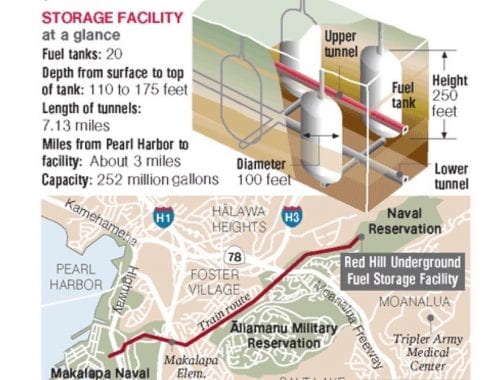As a relic of World War II “ingenuity”, the fuel tanks at Red Hill, O’ahu marks today’s militarized version of Flint, Michigan’s water crises. This ongoing story is currently being appealed in U.S. Courts by the Navy to resist emptying 20, 12.5 million leaking jet fuel tanks on the resting just 100 feet above the Honolulu Board of Water’s central aquifer for the region in the Halawa Shaft, which serves about 400,000 people. In November of 2021, the revealing of a major jet fuel leak was delayed by the Navy until some 93,000 residents complained of smelling and tasting jet fuel in their drinking water. These residents, many of whom were families at the local military base, have been displaced for the last three months as clean up of the water source ensues.
It was reported that some 14,000 gallons of jet fuel reached and contaminant the local water source. This is after the Navy disregarded efforts to previously shut down the facility, a strategic Pacific-Indo refuel station for the military, from a 2014 spillage that resulted in a 27,000 gallon leak into the local aquifer. Though studies conducted by the Navy itself finds that a 30,000 gallon leak has a 27% of happening any given year, The Department of Justice and the U.S. Navy are both fighting the emergency order issued by the State of Hawaii to drain the facility, which is backed by the Board of Water, Hawaii Department of Health, the EPA, and local organizations like Aina Momona, the Wai Ola Alliance, and the local Sierra Club chapter among thousands of concerned local citizens.
This act of environmental injustice is even more troubling when one considers the history of Hawai’i’s water culture their ahupua’a system. The Red Hill storage facility, which serves reserve fuel to Pearl Harbor 2.5 miles away, is located directly on the Halawa ahupua’a system, the region once home to Queen Emma. The disparity of land values in just 150 years is astounding and the future of O’ahu’s water is at stake in this on-going situation.
